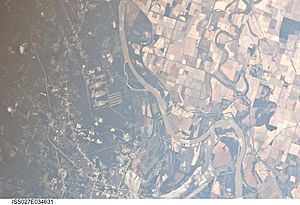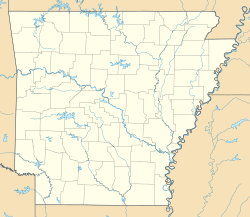Pine Bluff Arsenal facts for kids
Quick facts for kids Pine Bluff Arsenal |
|
|---|---|
| Jefferson County, Arkansas | |

NASA 2011 Satellite Photo
|
|

AMC Shoulder Sleeve Insignia
|
|
|
Location in Arkansas
|
|
| Coordinates | 34°19′57″N 92°05′12″W / 34.33250°N 92.08667°W |
| Type | Arsenal |
| Area | 13,493 acres (5,460 ha; 21.083 sq mi) |
| Site information | |
| Owner | |
| Open to the public |
No |
| Site history | |
| Built | November 2, 1941 |
| Built by | Corps of Engineers |
| Battles/wars |
|
The Pine Bluff Arsenal is a special base for the United States Army. It is located in Jefferson County, Arkansas, about eight miles northwest of Pine Bluff, Arkansas. It's also about thirty miles southeast of Little Rock, Arkansas.
This arsenal is one of only nine Army bases in the United States that used to store chemical weapons. Today, it makes, stores, and takes care of important supplies for the military. It also helps the Armed Forces and Homeland Security with special technical support. The arsenal creates and fixes things like smoke grenades, riot control items, and gear to protect against chemical or biological threats. It's also the only place in the Northern Hemisphere that fills certain types of munitions with a substance called white phosphorus. For Homeland Security, the arsenal trains first responders and keeps an eye on important equipment.
Contents
History of Pine Bluff Arsenal
Starting During World War II
The Pine Bluff Arsenal began on November 2, 1941. Its first job was to make special grenades and bombs that created fire. The land for the base, about 5,000 acres, was bought from a local doctor. It was first called the Chemical Warfare Arsenal. But four months later, its name was changed to Pine Bluff Arsenal.
During World War II, the base started making more things. It produced items for riot control and chemical-filled munitions. At the busiest time of the war, the arsenal also made special gases and chemical compounds. These were put into artillery shells and bombs.
The Cold War and Later Years
After World War II, some captured German rockets were accidentally launched. These rockets contained a substance called mustard agent. From 1953 to 1969, the arsenal also worked with biological agents. However, these operations stopped when President Nixon banned biological weapons. All biological agents at the base were destroyed between 1971 and 1973.
Pine Bluff Arsenal in the 21st Century
In the 21st century, the Pine Bluff Arsenal safely stored old chemical weapons. These included rockets, land mines, and large containers. These items were kept in high-security buildings and watched carefully. The U.S. Army Chemical Materials Agency finished destroying them safely by November 2010. The arsenal also stored other items that were not part of the main chemical weapons stockpile.
The U.S. Army Chemical Material Agency completed several important cleanup projects at the arsenal. These projects helped the United States follow international agreements about chemical weapons.
Cleaning and Recycling Containers
One project was the Pine Bluff Ton Container Decontamination Facility (PBTCDF). It started in September 2003. Its job was to clean and recycle over 4,300 large steel containers. These containers once held hazardous materials. They needed to be cleaned to remove any leftover chemical hazards. Workers heated the containers to 1000 degrees Fahrenheit for 60 minutes. This process made sure the containers were very clean and safe. After cleaning, the steel was recycled. This project finished in July 2011. It recycled over 6.5 million pounds of steel!
Destroying Old Munitions
Another project was the Pine Bluff Explosive Destruction System (PBEDS). It began in June 2006. Its goal was to destroy more than 1,200 recovered chemical warfare munitions. These were the largest number of recovered chemical warfare items in the country. The system used special units to safely open the munitions. Then, the chemical agent inside was made harmless. This project destroyed items like 4.2-inch mortars and German Traktor rockets. The PBEDS finished destroying the last munition in April 2010. This meant all non-stockpile materials declared by the U.S. were destroyed.
Destroying Former Production Buildings
The arsenal once had two buildings that made chemical warfare materials. These buildings also needed to be destroyed to follow international agreements. One building, the BZ Fill Facility, was destroyed in 1999. It used to fill munitions with a substance called BZ.
In 2003, work began to tear down the Pine Bluff Integrated Binary Production Facilities (PB IBPF). These facilities were designed to make and fill "binary" chemical weapons. These weapons were meant to mix two non-harmful chemicals together during flight to create a chemical agent. Many parts of this facility were never used. The last building of the PB IBPF was destroyed on December 28, 2006. This marked the end of destroying all former chemical warfare production facilities in the United States. About 2,800 tons of metal from these buildings were recycled.
Identifying Chemical Agents
The Pine Bluff Munitions Assessment System (PBMAS) was used to figure out what was inside recovered items. PBMAS used X-ray systems to check the contents and condition of items. This helped ensure safe handling and disposal.
Destroying Chemical Agent Identification Sets
The Rapid Response System (RRS) was a special mobile technology. It processed over 5,300 Chemical Agent Identification Set (CAIS) items. These items were once stored at the arsenal. The RRS started in August 2005 and finished in November 2006.
For many years, the arsenal stored rockets containing chemical agents. In the 1980s, these rockets were emptied, and their warheads were destroyed. Substances like mustard agent, VX, and G-series nerve agents were stored in large bunkers on the base.
In June 2005, a fire broke out in a warehouse at the Pine Bluff Arsenal. It was thought that a leak in a container of white phosphorus caused the fire. White smoke from the fire could be seen as far as 6 miles away. After about 19 hours, the fire was put out. Officials reported that over 7,500 canisters of white phosphorus were destroyed. The Pine Bluff Chemical Activity used to hold 12 percent of the nation's chemical weapons stockpile. This stockpile was safely destroyed between March 2005 and November 2010.
Facilities at Pine Bluff Arsenal
The Pine Bluff Arsenal covers a total area of about 13,493 acres. It has 665 buildings and 271 igloo-shaped storage units. These buildings and units offer over 2 million square feet of storage space. The arsenal also has more than 5,000 acres of land that could be developed in the future. Most people who work at the arsenal are civilians who work for the Department of Defense.
What Pine Bluff Arsenal Can Do
The Pine Bluff Arsenal has many important abilities. These include:
- Making and testing equipment for chemical defense.
- Creating systems to protect people from chemicals and to clean up chemical contamination.
- Monitoring chemical materials.
- Doing machining, fabrication, and assembly work.
- Producing specialized ammunition.
- Making "less than lethal" ammunition, which is designed to control situations without causing deadly harm.
- Ensuring high quality and providing joint logistics services for the military.



